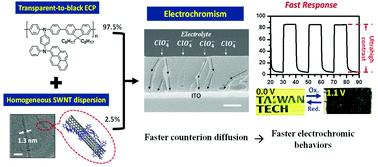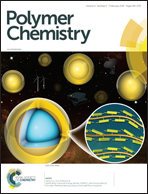Transmissive-to-black fast electrochromic switching from a long conjugated pendant group and a highly dispersed polymer/SWNT†
Abstract
In this study, a novel conjugated polymer, denoted as ECPblack, is synthesized. ECPblack demonstrated a unique electrochromic behavior with an ultrahigh contrast ratio (over 80%) in most of the visible regions, boasting an ultrahigh integrated contrast ratio of 71.8% between 380 nm and 880 nm. The long conjugated pendant group (pyrene) in ECPblack enhances the absorption in the blue region in its second oxidized state and results in transmissive-to-black electrochromic switching between the neutral state and the oxidized state. The transmissive-to-black electrochromic switching polymer with an ultrahigh contrast ratio could be especially attractive for applications in electronic displays. In addition, when polytriarylamine/nanotube (SWNT/P2) dispersion is doped in ECPblack, the response time of its electrochemical and electrochromic behaviors is further reduced. The electrochromic switching and bleaching time of SWNT/P2/ECPblack decreased by 73% and 80%, respectively. The improvement is caused by the phase separation of the rigid SWNT and the flexible polymer, which generates a rough surface morphology and provides more pathways for faster diffusion of counterions (ClO4−). The polymer/SWNT doping technique provides a simple way to accelerate ion diffusion in anodically coloring materials.



 Please wait while we load your content...
Please wait while we load your content...